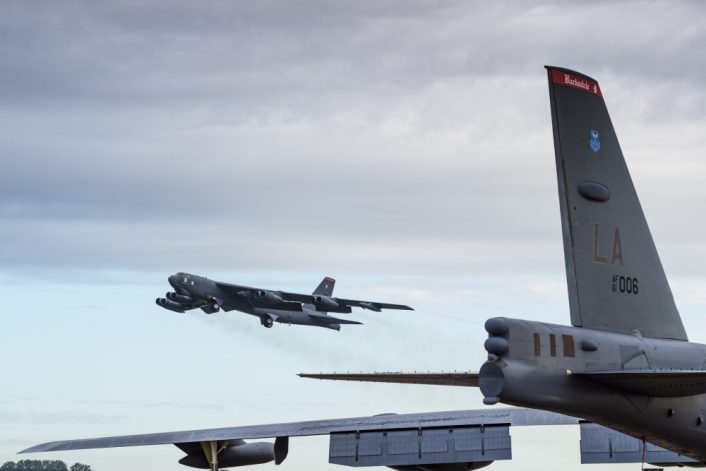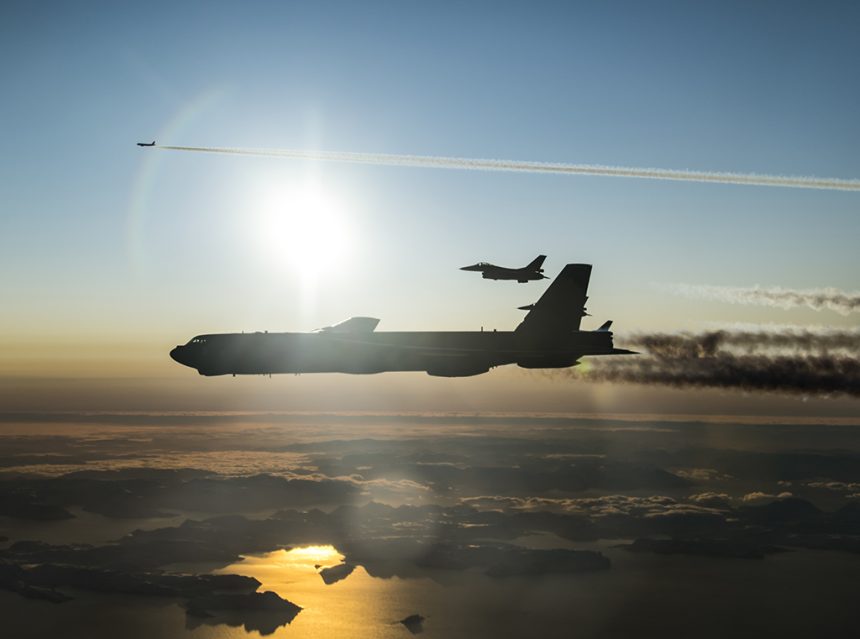During the deployment the bomber flew over 13 countries. A B-52 also made the type’s first ever landing in Greece.
After a month-long deployment to RAF Fairford, the B-52 Stratofortresses of Bomber Task Force Europe 20-1 returned to their home base at Barksdale AFB on November 8, 2019. The four bombers, belonging to the 20th Bomber Squadron and the 96th Bomber Squadron of the 2nd Bomb Wing, arrived in the United Kingdom on October 10 and flew daily missions across NATO airspace.
BRIG01 USAF B52 61-0006 and refuelling tankers airborne heading in direction of Lands End. This appears to be the end of their current UK deployment at RAF Fairford and now heading home to US @freedar_uk @BunkerAlpha pic.twitter.com/1ZO4VfMywH
— Spirit of Resistance 🇬🇧 (@G0ISW) 8 novembre 2019
In a press release on the day of the arrival, Gen. Jeff Harrigian, commander of the U.S. Air Forces in Europe and Air Forces Africa, said about the deployment: “Bomber Task Force rotations provide us with a consistent and near-continuous long-range weapon capability, and represent our ability to project air power around the globe. They also provide invaluable opportunities to train and integrate with our allies and partners in the Black Sea, Baltic and the Arctic regions.”
As anticipated by General Harrigian, the B-52 flew all over Europe and the Mediterranean Sea, with a mission also to Saudi Arabia. “The team arrived on 10 October with four B-52s, and in that time we’ve flown 32 sorties, we’ve integrated with 13 of our partner and allied nations here [in Europe]”, said Lieutenant Colonel John Baker, Commander of the 96th Bomb Squadron during the media day at the end of the deployment.

The bombers flew various missions over the Baltic region and a 12 hours mission over the Black Sea on Oct. 19, already covered by our editor David Cenciotti in a previous article with an OSINT analysis, and a couple of missions to the Eastern Mediterrean and Saudi Arabia, where a B-52 escorted by four Saudi F-15C Eagles performed a low pass over Prince Sultan Air Base on Nov. 1. During the return leg of the latter flight, the bomber diverted to Souda Bay due to adverse weather conditions at Fairford. The landing at Souda marked the first ever landing of a B-52 in Greece. The last mission before the end of the deployment saw a visit to the Arctic Circle on Nov. 6.
DETERRENCE | A @usairforce B-52H Stratofortress, accompanied by four Saudi Arabian F-15C Eagles, conducts a low pass over Prince Sultan Air Base, Saudi Arabia, Nov. 1, 2019. The B-52H, deployed from Barksdale AFB, La., is part of a Bomber Task Force operating out of @HQUSAFEPA. pic.twitter.com/d2TzDou4Hg
— US AFCENT (@USAFCENT) 1 novembre 2019
Check out these photos of our unexpected, but welcome, visitor this week!
A #B-52 #Stratofortress bomber was diverted to land @NSA_SoudaBay due to adverse weather at its destination – marking the first time a B-52 landed here.@USEmbassyAthens @HQUSAFEPA pic.twitter.com/1V0OymH9xB
— NSA Souda Bay (@NSA_SoudaBay) 8 novembre 2019
3 B-52s from #BomberTaskForceEurope integrated w/Royal Norwegian Air Force F-16s over the Barents Sea region of the Arctic Circle, Nov. 6.
The mission contributes to global stability & strengthening of the @NATO alliance.
That’s what we call #airpower!@usairforce @US_EUCOM pic.twitter.com/T0IDnbu0Nj
— USAFE-AFAFRICA (@HQUSAFEPA) 6 novembre 2019
The bombers integrated with numerous allied assets during their flights, such as British Typhoons, French Rafales, Czech Gripens, Norwegian, Hellenic and Polish F-16s, Saudi F-15Cs, US Navy P-8s and US Air Force F-22s, which practiced training intercepts (or Tango Scrambles) and High Value Airborne Asset protection missions.
The #B52s from Barksdale AFB have been flying many missions…most recently integrating with Polish F-16s over the Baltic Sea region.
Check out what joint, allied #AirPower looks like! @mblaszczak @MON_GOV_PL @usairforce @PolishEmbassyUS pic.twitter.com/P9Ytf4lWMK
— USAFE-AFAFRICA (@HQUSAFEPA) 1 novembre 2019
A #USAirForce B-52H Stratofortress is escorted by #HellenicAirForce F-16 Fighting Falcons over the #Mediterranean Sea in support of a #BomberTaskForce mission in #Europe 20-1, Nov. 1, 2019.#Greece #Cyprus #BomberTaskForceEurope pic.twitter.com/SEHcOKuCQR
— Emerson (@EEmerson14) 3 novembre 2019
.@Armee_de_lair et @usairforce côte à côte.
Nos entrainements communs améliorent notre interopérabilité et construisent des relations + fortes entre nos flottes aériennes. #NousSommesOTAN 🇺🇸🇫🇷 pic.twitter.com/ZDv1Gly0mh
— USA en Français (@USAenFrancais) 30 ottobre 2019
Also, during their stay in Europe, the bombers were joined by two other B-52 and two B-2 that took off from their bases in the USA, performed a flight mission over the Baltic region and then returned home, as part of Global Thunder 20, US Strategic Command’s annual nuclear command and control exercise.
#DeterrenceOnDisplay! #B52 & #B2 bombers depart for a #BomberTaskForce mission in #Europe. This mission is part of #GlobalThunder 20, our annual nuclear command & control exercise that enhances #readiness. #Deterrence #Assurance
More: https://t.co/y7kQk702Sh pic.twitter.com/JKcKfj5E3i
— US Strategic Command (@US_Stratcom) 28 ottobre 2019
Back in theater! A B-2 stealth #bomber refuels from a @RAFMildenhall KC-135 over the skies of Europe during @US_Stratcom Exercise #GlobalThunder Oct. 28.
This annual command & control training evt has a specific focus on nuclear readiness. @usairforce @US_EUCOM @AFGlobalStrike pic.twitter.com/HmIzhbfk00
— USAFE-AFAFRICA (@HQUSAFEPA) 29 ottobre 2019
Although not confirmed in an effort to preserve the operational security (OPSEC), it is rumored that the BUFFs (Big Ugly Fat Fellas, as the B-52s are affectionately known) will be back to Fairford next year, with possible visits also of B-1 and B-2 bombers.









